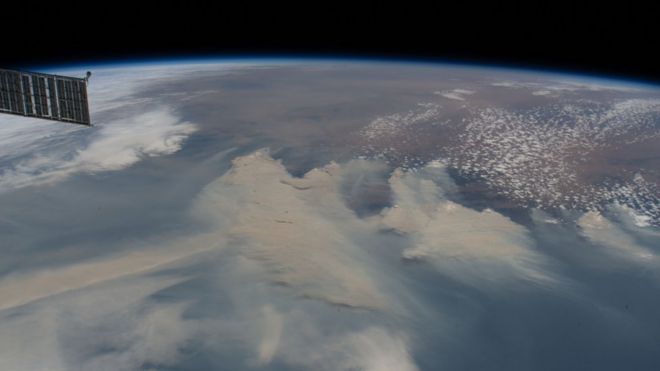Australia fires: Smoke to make ‘full circuit’ around globe, Nasa says

‘We have observed an extraordinary amount injected into the atmosphere,’ space agency says
Jon Sharman Tuesday 14 January 2020
Smoke from the wildfires that have devastated swathes of Australia is so extensive it will circle the planet to blight the country again, Nasa has said.
Experts said the volume of atmospheric debris generated by the months-long fires was “extraordinary”, and had already had a severe impact on nearby New Zealand.
The smoke has so far travelled more than 4,000 miles – with hazy skies reported as far away as Chile – and risen into the lower stratosphere, tens of thousands of feet up, a UV index created by Nasa from satellite data showed.
“The smoke is expected to make at least one full circuit around the globe, returning once again to the skies over Australia,” the US space agency said in a statement.
“Over the past week, Nasa satellites have observed an extraordinary amount of smoke injected into the atmosphere from the Australian fires and its subsequent eastward dispersal.”
The warning came as a tennis player collapsed on court and was forced to retire from Australian Open qualifying, after suffering a coughing fit brought on by wildfire-linked poor air quality. Slovenian Dalila Jakupovic retired at 6-5, 5-6 against Switzerland’s Stefanie Vogele, while the Canadian Eugenie Bouchard was also forced to take a medical time-out because of a sore chest.
Exacerbating problems on the ground and in the air are storms known as pyrocumulonimbus events, which the wildfires have generated. They occur when moisture becomes trapped in smoke in the cold upper air and forms a cloud that produces dry lightning.
These fire-induced thunderstorms have pushed smoke into the stratosphere, allowing it to travel much further and affect atmospheric conditions around the world.
“The effects of those events – whether the smoke provides a net atmospheric cooling or warming, what happens to underlying clouds – is currently the subject of intense study,” Nasa said.
The agency added that there had been noticeable impacts on Australia’s neighbour New Zealand, saying: “The smoke is ... causing severe air quality issues across the county and visibly darkening mountaintop snow.”
The fire threat in Australia is most acute in rural communities but low air quality continues to plague the major cities, with Victoria Health saying Melbourne’s air was the worst in the world early on Tuesday.
Blazes have been burning since September and have killed 28 people, destroyed more than 2,000 homes and led to the evacuations of thousands of people. Animals, including koalas, kangaroos and bats, have died in their hundreds of millions.
Thousands more attended demonstrations in Sydney and Melbourne late on Friday, calling for the country’s prime minister Scott Morrison to be sacked and for Australia to take tougher action on climate change.
Mr Morrison has admitted that his personal response to the wildfire crisis has been lacking, saying: “There are things I could have handled on the ground much better.”
The Liberal Party PM has been given a frosty reception by people he visited, having gone on holiday in Hawaii while blazes swept his country

NASA Goddard @NASAGoddard
https://twitter.com/i/status/1215370818156466190
A fleet of NASA satellites working together has been analyzing the aerosols and smoke from the massive fires burning in Australia. https://go.nasa.gov/2NavsuY
1:32 PM · Jan 9, 2020·
Additional reporting by Press Association
No comments:
Post a Comment